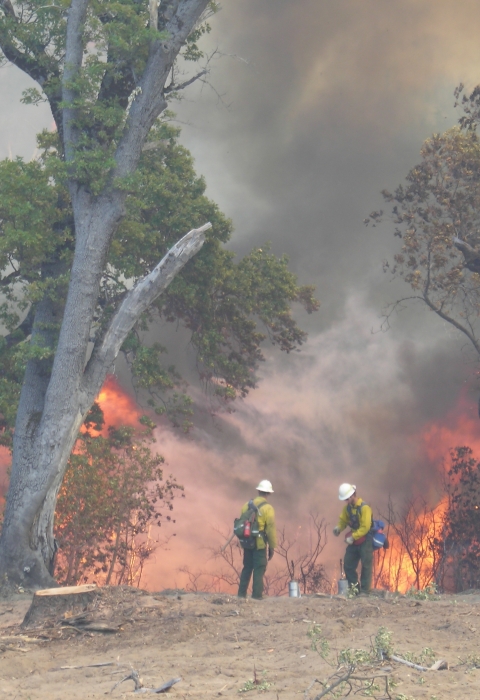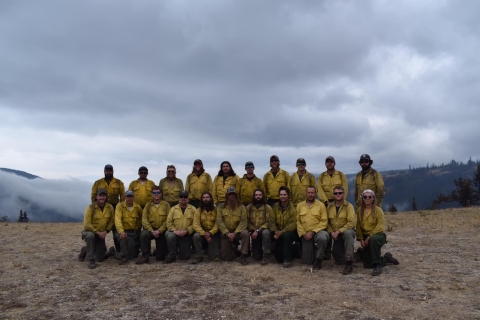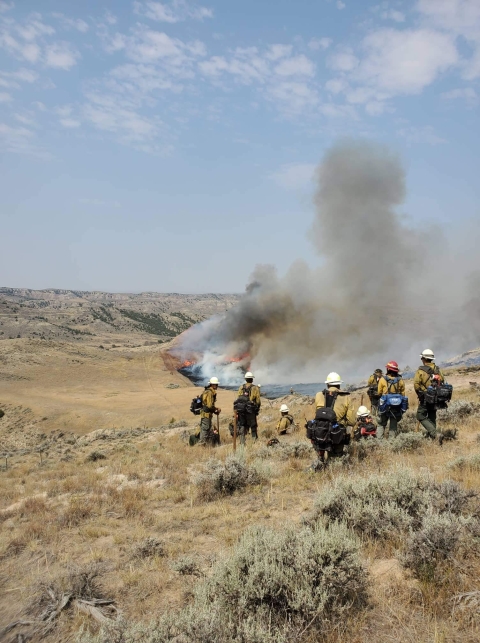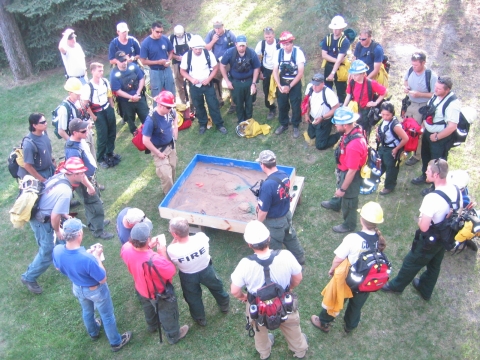Late into the sweltering summer of 2003, while wildfires raged across much of the Northern Rockies and Eastern Great Basin Geographic Areas, three fire managers huddled over a napkin and mapped out the blueprints for the conception of an interagency type 2 hand crew composed of firefighters out of Nebraska and Kansas (and later southern Colorado). All three fire managers believed the experience gained while working on a hand crew is invaluable, and by the following summer, the Mid-Plains Fire Management Zone in the Mountain-Prairie Region welcomed their newly formed crew.
Hand crews are the backbone of the U.S. Fish and Wildlife Service fire response and are made up of diverse teams of type 1 and 2 career and temporary wildland firefighters. These crews typically consist of 18 - 20 crew members and are responsible for wildfire suppression activities in adverse climate, fuel, and terrain conditions. The difference between a type 1 and type 2 hand crew lies in the amount of training hours, as well as training topics completed. A type 2 hand crew is generally considered slightly less experienced than their type 1 counterparts. All hand crews are assigned duties on wildland and prescribed fires that primarily consist of constructing firelines with hand tools and chainsaws, burning out areas using drip torches and other firing devices, mop-up or clean-up, and rehabilitation of burned areas.
Although there is no lead agency or organization, the Mid-Plains Interagency Handcrew is hosted at Quivira National Wildlife Refuge in Kansas. One of the original founders of the hand crew, Bill Waln, fire management officer (FMO) for USFWS’ Mid-Plains Fire Management Zone, serves as the FMO for the crew. In previous years, without the existence of a formal interagency hand crew in the region, opportunities for fire personnel to gain experience on a hand crew were extremely limited.
Year after year, one of the most challenging aspects of the hand crew is the mobilization process. Crew members are dispatched from three dispatch centers within the Rocky Mountain Geographic Area, and with crew members coming from different agencies, units, and organizations, a minimum of two to three days is required to assemble the crew. All crew members commit to being available for 14 days and once mobilized, they must commit to an incident for an additional 14 days.
The crew’s primary mobilization point is Rocky Mountain Arsenal National Wildlife Refuge in Colorado. Each firefighter will report with all the necessary hand tools and equipment needed to staff the crew. Crew members arrive in their own agency trucks, allowing for the formed Mid-Plains Interagency Handcrew to choose between numerous options.
Given this crew is an interagency hand crew with firefighters coming from Nebraska, Kansas, and Colorado, crew cohesion can sometimes be a concern. Until mobilization, there is little opportunity for crew members to work together. To ease these concerns, every effort is made to host a one-week training and orientation session before fire season. Not only does this provide the necessary training to crew members, but it allows them to become familiar with one another and break down any unnecessary barriers.
“From day one, leadership is stressed to each crew member,” Waln says. “The crew strives to always be service oriented, regardless of what agency they come from. This ‘servant-first’ attitude and leadership style creates a team atmosphere in which crew members thrive and develop new skills.”
Throughout the years, the Mid-Plains Interagency Handcrew has seen crew members from many wildland firefighting agencies, including: U.S. Fish and Wildlife Service, Kansas Forest Service, Bureau of Indian Affairs, Pueblo Interagency Dispatch Center, Hutchinson Community College, U.S. Forest Service, National Park Service, Hutchinson (KS) Fire Department, Littleton (CO) Fire Department, Denver (CO) Fire Department, Colorado State Forest Service, and Bureau of Land Management.
Original creators and founders of the Mid-Plains Interagency Handcrew include: Waln; William “Pat” Harty, previously prescribed fire specialist at LaCreek National Wildlife Refuge in South Dakota and currently the Bureau of Land Management fuels specialist in Montana; Rodney Redinger, previously the training manager for the Kansas Forest Service, currently the assistant fire management officer for operations/training for the Kansas Forest Service.
This story is part of our Open Spaces blog.







